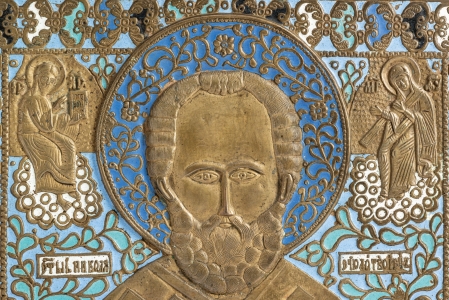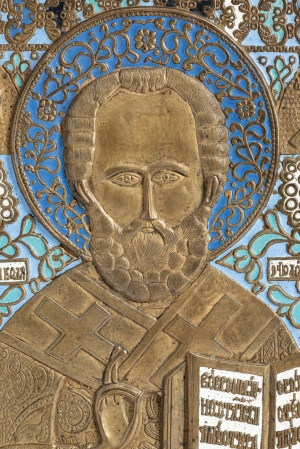The copper alloy objects constitute the largest group of church furnishings from Russian Christianity in ancient times. They are largely conserved in Russian collections both private and of museums, but they are also found in many western European collections. These art pieces appeared in Russia during the time of Christianization. At first, they were imported from Byzantium, a fact proven by the archaeological findings in Kiev, in the Chersonese and in other cities in the south of Rus’. The continuity of a high value artistic tradition of Byzantine art was mirrored in technique, in forms and in the subjects of the first ancient Russian bronze pieces of which there is evidence dating to the XI century. The archaeological findings of stone matrixes and ruins of craft workshops in ancient Kiev are proof that in the XI century there was already a thriving production of baptismal crosses, enkolpion (that is, pectoral reliquary —crosses), double faced medallions called zmeevik and small icons. In the course of the following centuries the production of objects created in copper alloys developed in many ancient Russian cities. Novgorod and Moscow became the most important centers. In the early XVIII century, the bronze production of sacred objects was threatened to almost total extinction.
In 1722 there was a decree by Emperor Peter I “On the ban of using engraved and cast icons in churches and private homes”, and in an imperial decree dated 1723 it was written that “… copper and tin icons, except for pectoral crosses … from now on must not be cast and all merchants are forbidden sell them”. The official Russian Church was forced to be subject to this law that prohibited the production of obrazki, small icons and bronze polyptychs. Nevertheless, in spite of the law and the will of the authorities, the XVIII century was a flourishing period for the fusion of bronze, connected to the — the Old Believers, who opposed the official Russian church after the reforms by the patriarch Ni.
Bronze objects from the XVIII — the early XX centuries constitute a part of the Old Believers’ hey it cannot be ignored, they continued developing ancient Russian art. It is in this manner that the c objects, medallions, polyptychs, and crosses with various functions reflect one thousand years o, art history in Russia. The characteristics of the works in bronze, dictated by the same material and the technique for production, or better yet, the possibility for being produced in large quantities, their durability, sm.° dimensions, beauty and relatively low price, favored their wide spread in all strata of the population above all as personal objects of devotion. They were greatly requested throughout the immense Russian territory. In all circumstances of life, joys and sorrows, the Russian Orthodox would revert in prayer to these sacred objects: they were metal crosses, polyptychs that substituted entire iconostasis, and icons portraying the Savior, the Mother of God and the saints, who gave help during times of misfortunes and were particularly worshiped by the population. These holy objects, durable and low priced, were convenient when travelling long distances. In quality of patron saints, the small icons and polyptychs were taken on long trips by their owners; they were used to bless war expeditions and other important events. According to popular beliefs, the copper pieces, in particular the pectoral crosses and small icons, possessed magical powers.
That which became a distinguishable characteristic of the major works produced in workshops for bronze fusion by the Old Believers from the XVIII – the early XX centuries, were the polychrome enamels, remarkable for their beauty, variety and quality; they covered the background and edges the icons, polyptychs and crosses with admirable inflorescence. The copper icons covered with the enamels created various evocative shades in the icon’s emotional receptiveness; color is a great instrument of spiritual influence, the distinctiveness of which medieval culture was well aware of and used. The Old Believers, as keepers and continuators of the ancient Russian traditions, understood how important the use of color was in the bronze artefacts, that is why the majority of the Old Believers’ bronze works stand out, because of the unrepeatable coloring.






















